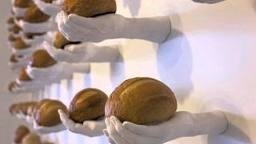My wife loves focaccia. One of her favorite snacks is a naked piece of focaccia topped only with its pre-bake sprinkling of coarse sea salt. We've been making focaccia for about a decade, using a bread machine recipe, and our Zo on dough cycle. Once fermented, I'd stretch the dough onto a half-sheet pan, and bake it in the oven. Here's a link to a focaccia bake I posted in the first month after I'd joined TFL.
http://www.thefreshloaf.com/node/11810/bread-machines-you%E2%80%99ve-come-long-way-baby
Shortly, following I became obsessed with sourdough, baguettes and, to a lesser degree, challah. That trinity has kept me busy for the past three years, and although we didn't abandon our bread machine dough making, we only use it routinely for tried-and-true sandwich bread dough, and on occasion the reliable, but uninspiring focaccia which we also like for sandwich making.
Now, reasonably certain I can produce a satisfactory loaf of any of the trinity, my curiosity has turned to reexploring other bread styles. My thoughts had settled on either ciabatta, or focaccia when my wife settled the matter, asking for focaccia. When questioned, she allowed she wanted it mostly for sandwiches. At that momemt I decided I'd bake focaccia buns, in lieu of the usual single flat rectangle.
I first considered making the well-known, and safe, bread machine recipe and incorporating an overnight retarded bulk fermentation, striving for additional flavor. However, searching further I found Maggie Glezer's formula for Acme Bakery Herb Slabs: a styleized focaccia in her Artisan Baking book. She had adapted Acme's four-hour poolish to an overnight twelve-hour poolish, finishing with a making the dough and subjecting it to an approximately six-hour bulk fermentation, with early S&Fs, at room temperature.
I've become an advocate for overnight retarding at low temperature (54°F) so I planned an eight-hour poolish, followed by mixing the dough (DDT 54°F) and invoking a fifteen-hour retarded bulk fermentation, with early S&F. I followed Ms. Glezer's ingredient ratios to the letter, with two very small variations: 1.) I used Instant Dry Yeast, mixed directly into the poolish flour (1/8th tsp) and the final dough flour ( 1/4 tsp), and 2.) I made the poolish hydration exactly 100%. Ms. Glezer specifies a main water ingredient amount that yields a hydration of 98%, and some manipulation of the yeast in 1 cup of water--only a quarter of a cup of the yeasted water is used--resulting in 1/16th tsp of yeast, and additional grams of water, which leads to 118% poolish hydration. This percentage is annotated parenthetically after the main water ingredient as "(eventually 118%)". Frankly, I didn't understand all this unusual baker's math at the time I was mixing the poolish. Using the K.I.S.S. principle I simply made it 100%. Only, now writing this blog, did I piece together her instructions. Oops! 3.) I also left out the herbs--intentionally.
When I retrieved the dough in the morning, after 15 hour bulk fermentation, it had tripled in volume. I turned it out, degassed it, and pre-measured 4, 180g; 2, 120g; and 1, 270g dough pieces. These corresponded to 4 large oval baking dishes, 2 small oval custard dishes, and 1, 8"x 8", square baking pan. I preshaped the dough into balls, and let them warm in the proofing box (82°F) for 1 hour. After panning I brushed the tops with a generous coating of olive oil. After proofing I poked finger-holes in the top and sprinkled two large ones, the two small ones and the square with coarse sea salt, the remaining two large ones with black pepper and grated parmesan. I baked them at 425°F for twenty-two minutes (Convection mode). I didn't use steam, thinking the loaves, coated with olive oil wouldn't benefit. I've also found salt begins to dissociate in steam.


This dough was wonderful to work with (although slightly sticky), however, my not understanding the directions resulted in a dough that was 62% hydrated. Had I followed directions correctly the the dough's hydration would have been 75%, and I would have had a crumb very different than what I got (and a much sticker dough). Nevertheless, not all mistakes lead to bad results. This crumb is more than acceptable, for us, in a sandwich bun, and the flavor is excellent.
I'll make these again. I will likely increase the dough hydration, but probably only to 68%, the same hydration I now typically use for baguettes. This dough, with the exception of 6% olive oil, is essentially the same as the baguette dough I make in both ingredients and handling. I achieve a very open crumb in baguettes, not a crumb I especially like in a sandwich bun. Subsequently, I'll raise or lower the hydration as it fits our tastes. I also will experiment with using the baking dishes and custard dishes as bannetons, and bake the unpanned loafs on the baking stone. I had to use two racks for this bake, which gave me a two differing browning depths and patterns.
David G









